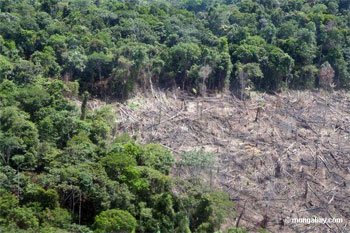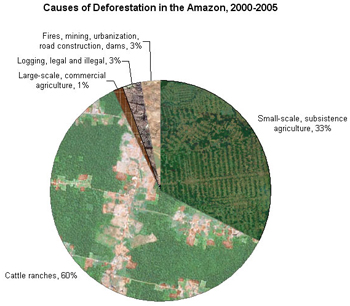Scientists today warned that 40 percent of the Amazon rainforest could be lost by 2050 due to agricultural expansion unless strict measures are taken to protect the world’s largest tropical forest.
Britaldo Soares-Filho, of the Universidade Federal de Minas Gerais in Brazil, and a team of scientists used computer simulations to model the future extent of Brazilian rainforests under different scenarios and found that “by 2050, current trends in agricultural expansion will eliminate a total of 40 percent of Amazon forests, including six major watersheds and ecoregions”. The research is published in the journal Nature.
“For the first time, we can examine how individual policies ranging from the paving of highways to the requirement for forest reserves on private properties will influence the future of the world’s largest tropical forest,” said Soares-Filho in a statement.
The Amazon rainforest is disappearing due to conversion of forest land for cattle pasture and agriculture. Logging, mining and infrastructure development are also contributing to pressure on the region’s forests, which are among the most biodiverse on the planet. Scientists estimate that perhaps 30 percent of the world’s species are found in the Amazon.
 Amazon deforestation. |
The bulk of Amazon rainforest is found in Brazil, which today houses about one-third of the world’s remaining rainforests. This region has experienced an exceptional extent of forest loss over the past two generations—an area almost certainly exceeding 600,000 square kilometers (232,000 square miles), or about 15 percent of its total surface area of 4,005,082 square kilometers, has been cleared in the Amazon since 1970, when only 2.4 percent of the Amazon’s forests had been lost. The increase in Amazon deforestation in the early 1970s coincided with the construction of the Trans-Amazonian Highway, which opened large forest areas to development by settlers and commercial interests. In more recent years, growing populations in the Amazon region, combined with increased viability of agricultural operations, have caused a further rise in deforestation rates. Since the close of the 1990s, annual deforestation rates of primary forest cover in Brazil have climbed by 35 percent.
Recent studies indicate that these figures do not include extensive areas degraded by fires and selective logging. Research led by the Woods Hole Research Center and the Carnegie Institution’s Department of Global Ecology found that each year the amount of forest degraded is roughly equivalent to the amount of forest cleared. The finding is trouble to ecologists because degraded forest has lower levels of biodiversity and is more likely to be cleared in the future. Further, degraded forest is more susceptible to fires.
There is also concern that climate change could cause as much as half the Amazon rainforest to revert to savanna. Computer simulations by the National Center for Atmospheric Research suggest that deforestation could cause surface temperatures to rise 2°C (3.6°F) or more across the Amazon by 2100, producing a significant drop in precipitation and resulting in a drier climate for the region. Declining precipitation could affect levels of rainfall as far away as Texas.
 Causes of Amazon deforestation. |
While the current outlook for the Amazon is poor, there are steps that can be taken to slow forest loss. The authors of the report say that by controlling agricultural expansion and increasing protected areas, 73 percent of the original forest would remain in 2050 and carbon emissions, that would otherwise result from deforestation, would be reduced. The scientists argue that because Amazon conservation would have worldwide benefits—from carbon sequestration, biodiversity preservation, fisheries protection, and climate regulation—developed countries should help pay for preservation efforts. Just such a proposal was made by a coalition of developing nations at the November climate meeting in Montreal. The Coalition for Rainforest Nations—a group of 10 forested countries—successfully argued for a plan that allows developing countries to receive financial compensation from industrialized countries for agreeing to protect their rainforests.
Sustainable development also offers promise in reducing rates of forest loss in the Amazon. Brazil recently unveiled a plan to allow sustainable logging across 3 percent of the Amazon with the hope that firms will be able to operate profitably without diminishing the resource base. If they can, it may open a new era for the sustainable management of tropical rainforests, the world’s most biologically diverse ecosystems.
Related articles
Amazon to be logged sustainably says Brazil March 6, 2006
Last week Brazilian president Luiz Inacio Lula da Silva announced a plan to allow sustainable logging across 3 percent of the Amazon rain forest. The law is aimed at undermining destructive illegal logging activities—currently responsible for most of the commercial timber extraction in the region—while generating revenue for forest management and protection, and income for rural Brazilians in the region who often must rely on subsistence agriculture or employment on ranches and plantations under sometimes slave-like conditions.
Parks, indian reserves slow Amazon deforestation January 25, 2006
new study shows that parks and indigenous reserves in the Amazon help slow deforestation. The study, conducted by researchers at the Woods Hole Research Center and the Instituto de Pesquisa Ambiental da Amazonia, analyzed the effectiveness of protected areas against forest clearing using quantitative analysis of satellite data. The study found that deforestation was 1.7 to 20 times higher along the outside versus the inside perimeter of reserves, while fires were 4 to 9 times higher. Indigenous lands also slowed forest clearing in high-deforestation frontier regions.
Amazon deforestation slows in Brazil for 2005 December 5, 2005
Deforestation in the Amazon rainforest fell 37% for the 2004-2005 year according to Brazilian government figures released today. Between July 2004 and August 2005, 7,298 square miles of rainforest (18,900 square kilometers) — an area almost half the size of Switzerland — were destroyed. Last year the figure was 10,088 square miles (26,129 sq km kilometers) and since 1978 some 211,180 square miles (546,905 sq km) of forest has been lost.
Pre-Columbian Amazon supported millions of people October 18, 2005
Controversial evidence uncovered over the past decade suggests that the Amazon rainforest was once home to large sedentary populations of people. Besides the well-known empires of the Inca and their predecessors, the Huari, millions of people once lived in the forests and shaped the environment to suit their own needs.
Drought, fire called biggest threats to Amazon rainforest ecosystem April 23, 2005
A prolonged drought in the Amazon could lead to a massive die-off in the world’s largest rainforest according to a study released in Science last week.